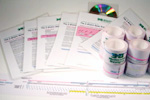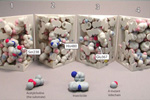Annotated Gene Maps and Bioinformatics
With the advent of rapid sequencing strategies developed in conjunction with the Human Genome Project, there is a plethora of sequence data just waiting to be analyzed! Many free online tools make it easy for bioinformatics activities to be brought into the classroom. We believe it is important for students to understand how the programs work – so we have developed some ‘paper bioinformatics’ activities in which students identify introns and exons, or compare two aligned sequences, or translate a nucleotide sequence. Once these introductory activities are used, students are better prepared to use the online tools.
CREST instructional activities exploring bioinformatics may involve the development of paper bioinformatics activities or activities involving online tools. This page includes sample activities and links to a few of the online tools. The Guidelines provide a framework for getting started but they are in no way exhaustive. If you are interested in developing a CREST activity that isn’t outlined here, please contact (crestprogram@gmail.com) for assistance in mapping out an approach to your application.
Examples

Map of the Beta Globin Gene – The purpose of this paper bioinformatics activity, available through the MSOE Model Lending Library and for purchase from 3D Molecular Designs, is to introduce students to gene structure, including introns and exons, promoters and splice site consensus sequences. Through a guided inquiry activity, students discover the concepts and then apply the appropriate terminology to the concepts.

Acetylcholinesterase – This activity, available through the MSOE Model Lending Library, explores insecticide resistance. Instructions permit the use of online bioinformatics tools – or paper printouts of the results – to align gene and protein sequences from mosquitoes that are sensitive and resistant to insecticides. The results of these alignments are used, in conjunction with physical models and Jmol tutorials, to explore the molecular basis of insecticide resistance. In an extension of the activity, students may propose a better insecticide design. Based on data from a Nature article published in 2002. (Weill et al. 2002. Insecticide resistance in mosquito vectors. Nature 423:136-137.)
Resources
FASTA Format
Nucleotide and peptide sequences are created in a standard format that is used by a wide range of bioinformatics tools. Single letter abbreviations identify nucleotides or amino acids, and the sequence ends with two forward slashes (//). Comment lines begin with the greater than symbol (>).
Blast Search
A query sequence (nucleotide or peptide) is used to search a database for similar sequences.
Alignment Tools
Two sequences can be compared for homology. Alignment scores are used to indicate how closely the two sequences align. Gaps typically reduce the score more than mismatched bases. Adjustments can be made in how gaps and mismatches are scored; length of a gap is not as significant in reducing alignment scores as the number of gaps.
- Aligning peptide sequences
- Aligning nucleotide sequences
- Multiple sequence alignment (nucleotide or peptide)
Translation Tool
Starting with a DNA or RNA sequence, you can determine the protein sequence. Select whether you want forward or reverse reading frames and whether you want one or all three reading frames in a given direction.
Websites with Useful Bioinformatics Tools
- ExPASy Bioinformatics Resource Portal
- University of Gothenburg Institute of Biomedicine – Divided into educational vs. research tools
- University of Guelph – Includes background information